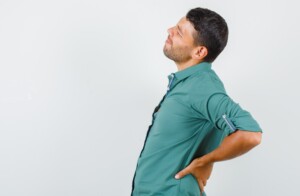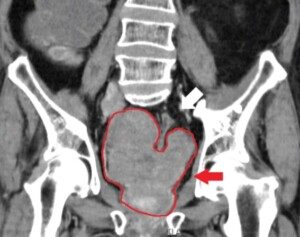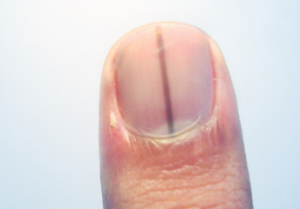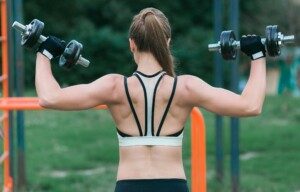
Most people don’t allow one dumbbell to stay tilted towards their head during a shoulder press.
But if it tilts downward it’s usually quickly corrected.
A tilt of both dumbbells, in symmetrical fashion, during an overhead press is commonly seen – when the tilt is away from the head or upward.
Dumbbell tilting towards the head with just one of the weights would typically arise when the weight suddenly feels heavier than anticipated.
However, tilting one dumbbell, as seen in the image at the top of this post, can also occur simply because the person lacks kinesthetic awareness.
In fact, the model had no idea she was doing it or, if she did, didn’t think it mattered. Neither did the photographer.
In real life, if the person is aware of this glitch, they may not think much of it or think nothing needs to be corrected.
But is this smart training?
It’s certainly not smart photography unless the photographer deliberately set it up that way and labeled it “example of poor form in a shoulder press.” It wasn’t labeled that way, though.
It’s an obvious error and it does need to be avoided.
When you’re doing an overhead press or shoulder press with dumbbells, keeping the weights under control is important. Flopping them should not be tolerated.
The downward tilt may feel natural at first, but it’s actually pretty risky.
When a dumbbell tilts toward you, the line of force shifts.
Instead of the weight going straight up over your shoulder, it moves closer to your body, which can put extra stress on your shoulder joint and rotator cuff tendons.
It may not feel different or uncomfortable to someone using light weights.
But if unchecked, this bad form can become a habit with heavier resistance.
It can lead to strains or even long-term injuries if it happens repeatedly.
Your shoulders are designed to move in certain planes.
Tilting the dumbbell changes the mechanics of the lift, which forces smaller stabilizing muscles to compensate.
Rotator cuff tendons can also get forced into the action in a way that they’re not designed to.
This poor form won’t suddenly tear a tendon, but habitual lifting this way can strain a tendon over time, leading to pain with overhead motions.
Other Effects of the Downward Dumbbell Tilt
When the dumbbell leans toward you, your wrist has to bend slightly to stabilize it, which increases the chance of wrist pain or injury.
A tilted dumbbell can pull your body off-center, making you rock back or arch your lower back to compensate.
Over time, that adds stress to your spine and can lead to back problems.
Correct this Issue Now
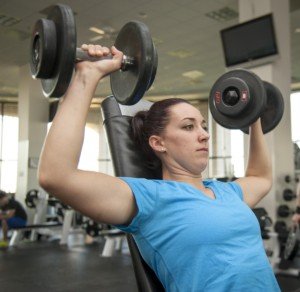
Keeping the dumbbells aligned over your shoulders keeps the force straight through your skeletal structure. Viewing yourself in a mirror will help.
They can be horizontal or tilted upwards away from your head.
Imagine the weights are open bottles of water, with the openings facing your head.
You don’t want to tilt them towards you to spill the water – even if both hands are doing this evenly. It can harm the rotator cuff.
Proper technique ensures that the target muscles — the deltoids, triceps and upper chest — get the most benefit from the exercise.
![]()











